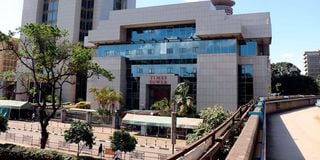KRA goes for staff as puzzle of missing Sh432bn deepens

The taxman was on Tuesday left scratching its head over the puzzle of missing Sh432 billion worth of imports from China on its books last year even as it emerged that the agency was in the middle of an internal staff shake-up that targets at least two commissioners.
KRA chairperson Anthony Ng’ang’a Mwaura said several senior officers at the border points, as well as ports, have been redeployed in an ongoing shake-up.
Those targeted in the shakeup include deputy commissioners as well as at least two commissioners.
“KRA is a no-go zone now and several transfers have taken place at our border points and ports. There is also a shakeup of deputy commissioners and one or two commissioners,” said Mr Mwaura.
The disparity in reports of the value of Chinese imports, first reported by the Business Daily, has been growing gradually for the last five years and hit its peak last year.
It has also emerged that the data from the General Administration of Customs of the People’s Republic of China (GACC), which is the equivalent of the Kenya Revenue Authority, has also negated an earlier explanation that some of the import gap might have been destined to other countries in the region through transhipment.
A fresh analysis of the data showed separate tabulations for exports to neighbouring countries including Uganda, Rwanda, Burundi, Tanzania, Ethiopia, Sudan, Burundi and the Democratic Republic of Congo.
Official data from the KRA for the first 10 months of last year, as published by the Kenya National Bureau of Statistics (KNBS), placed the value of imports from China at Sh377.5 billion.
However, GACC says on its website that the goods exported from China to Kenya during this period were valued at Sh809.4 billion — more than twice the figure given by the KRA.
A breakdown of the data going as far back as 2018 shows that the disparity has been growing gradually in the period from Sh155.7 billion in 2018 to Sh431.7 billion last year.
The variance since 2018 adds up to Sh1.26 trillion, which translates into billions of shilling in tax revenue losses. The KRA had not officially responded to Business Daily queries.
Sources, who could not be quoted as they are not allowed to talk to the press, said statisticians at the Times Tower, Nairobi, where the offices of KRA are located, were crunching the numbers to find the explanation.
“After adding all the numbers, they have not been able to get over Sh450 billion. So the gap is still huge,” said one of the sources.
This comes at a time the KRA is carrying out an internal audit to seal the loopholes that some Kenyans have been using to evade paying taxes.
Mr Mwaura said several senior officers at the border points, as well as ports, have been redeployed in an ongoing shake-up.
In a move to ensure full compliance in value-added-tax (VAT) payment, Mr Mwaura said they had decided to go for a machine similar to one used by revenue authorities in Rwanda.
The KRA sources said earlier that they were in contact with the Chinese Embassy in Kenya from whom they wanted to understand how Beijing computed its data following the Business Daily queries.
The Chinese Embassy did not respond to our query on how they computed the data and whether there was some cargo which was indicated as going to Kenya while their final destination was other countries.
This huge variation is also likely to bring into question the amount of taxes collected on imports from the world’s second-largest economy, as goods shipped into the country attract a myriad of levies, including import duty, value-added tax (VAT), excise duty, import declaration fees (IDF) and the railway development levy (RDL).
Kenya is grappling with a problem of trade misinvoicing, whereby imports or exports are misquoted at the port to avoid paying customs duties.
This form of tax evasion can also occur when there is import under-invoicing, which would cause fewer payments of VAT and customs duties due to the lower valuation of goods.
With trade misinvoicing, importers could under-declare the price of an imported item, such as a phone, or buy 10 phones but only declare two, a practice that is common with the consolidation of imported goods.
A 2018 report by Global Financial Integrity (GFI) estimated that Kenya potentially lost $907 million (Sh112.8 billion) in revenue in 2013 due to misinvoicing and illicit financial flows.
Second–hand clothes and cereals lost the largest revenue at $21 million due to import under-invoicing, vehicles at $18 million, electrical machinery at $17 million and mineral fuels at $15 million.
Lost revenue due to mispriced exports was related to the coffee, tea and spice trade, which accounted for $140 million.
The new administration of President William Ruto has prioritised the deployment of technology and enhanced data analytics at the customs and border control among the seven measures to scale up tax collection to Sh3 trillion in the upcoming financial year.
Imported goods are subject to import duty ranging from zero percent for raw materials to 10 percent for intermediate goods and 25 percent for finished products.
Except for a few exempted goods, VAT is charged at the standard rate of 16 percent while imported excisable goods will attract different excise duty rates as prescribed under the Excise Duty Act 2015.
Imported goods also attract import declaration fees at 3.5 percent and 2 percent railway development levy.





